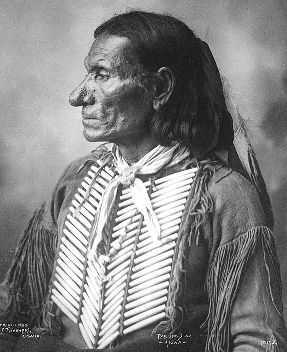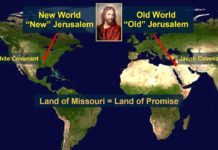There are many good books to read and learn from. There are many to stay away from. As the Lord said, And from time to time, as shall be manifested by the Comforter, receive revelations to unfold the mysteries of the kingdom; And set in order the churches, and study and learn, and become acquainted with all good books, and with languages, tongues, and people. D&C 90:14-15
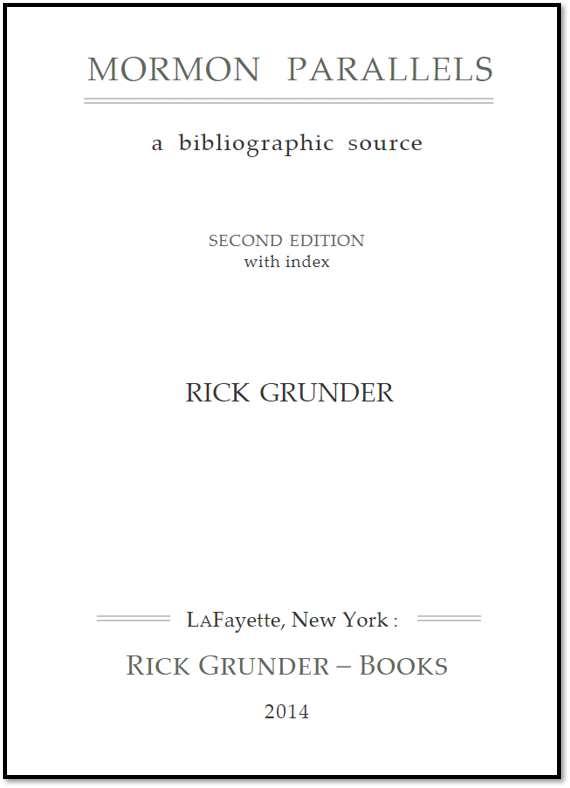 As I study Native Americans and there history side by side with the Book of Mormon, I have been drawn to this bibliographic source called, Mormon Parallels: by Rick Grunder. It makes historic reference to history, natives, and Book of Mormon parallels which I enjoy. As I read I am always thinking about the truth and doctrine I know in the Church of Jesus Christ of Latter-day Saints and seeking out of good books and history, the things that will add to the many truths I already know by the Sprit and witness of the wonderful Book of Mormon.
As I study Native Americans and there history side by side with the Book of Mormon, I have been drawn to this bibliographic source called, Mormon Parallels: by Rick Grunder. It makes historic reference to history, natives, and Book of Mormon parallels which I enjoy. As I read I am always thinking about the truth and doctrine I know in the Church of Jesus Christ of Latter-day Saints and seeking out of good books and history, the things that will add to the many truths I already know by the Sprit and witness of the wonderful Book of Mormon.
Ethan Smith was a New England Congregationalist clergyman in the United States who wrote View of the Hebrews, a book that argued that Native Americans were descended from the Ten Lost Tribes of Israel. I believe Lehi was from the Tribe of Manesseh, The daughters of Ismael from the Tribe of Ephraim and the Mulekites were from the Tribe of Judah. This measn the tribes of Joseph and Judah from Prophet Jacob or Israel have now bee joined together in the New World of North America.

Elder Snow said, “I am asked to occupy the few minutes yet remaining: If the Spirit gives me liberty I will pursue the train of thought that has passed through my mind while Brother Richards has been speaking upon the spirit that has gone abroad upon the remnants of the house of Israel who occupy this land, the American Indians whom we understand to be the descendants of the Nephites, the Lamanites, the Lemuelites and the Ishmaelites who formerly possessed this land, whose fathers we have an account of in the Book of Mormon.” The Indians—The Influence of the Elders Among Them in the Interest of Peace, Etc. Discourse by Elder Erastus Snow, delivered at Logan, Sunday Afternoon, February 5th, 1882
ETHAN SMITH said, “Many things may be fancied, relative to the kind and degree of evidence which shall discover and identify the ten missing tribes, while Divine wisdom may take such a method as may baffle the prejudiced and inform only the sincere enquirer.
‘If,’ says the Rev. E. Smith, ‘these tribes are the children of Israel, a new field of evidence of the truth of the holy Scriptures is opened from a race of men ‘outcast from civilized society for three millenaries. For impressed on these tenants of the forest are striking characters of the truth of revelation. . . .’ [p. 300, citing “Smith’s View of the Hebrews.”] Page 1576 Mormon Parallels
Book of Mormon Evidence.org believes The Book of Mormon events in the New World occurred in North America. The Church of Jesus Christ of Latter-day Saints is neutral on this subject. Our information is based on archaeology, anthropology, text of the Book of Mormon, distances, geology, and we believe the many rivers were the highways of the ancients including the Nephites.
Nephite Travel
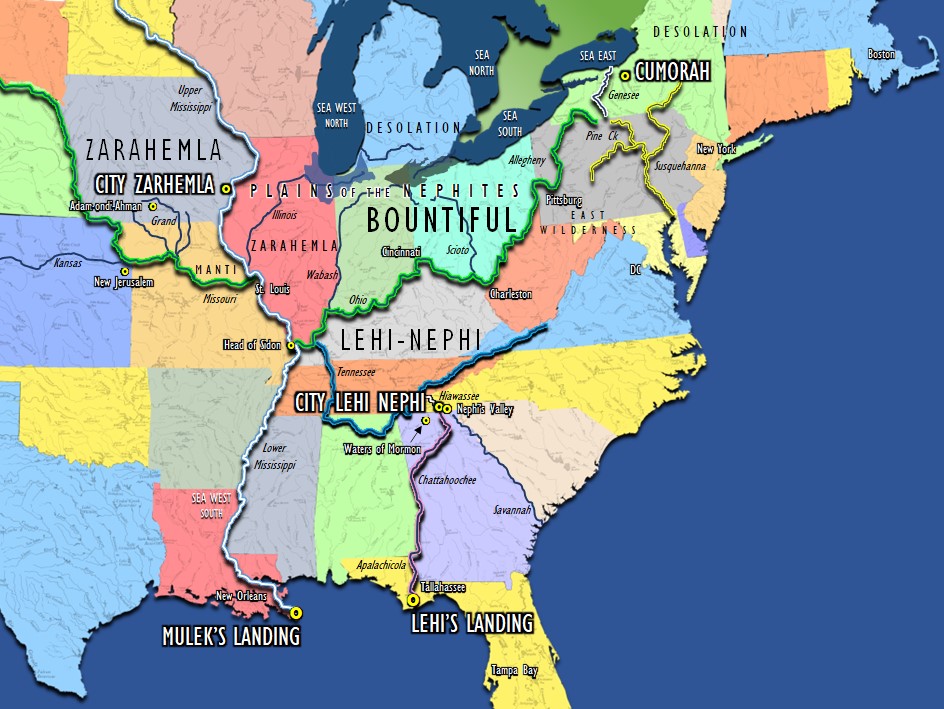 We believe Lehi landed in Florida near Tallahassee about 589 BC. Later, after Lehi dies, Nephi escaped north possibly using the Chattahoochee River to Unicoi Gap, GA, and then traveling on the Hiawasee River which connects to the Tennessee River then, settling near Chattanooga, Tennessee which area became the land of Nephi and also called the Land Lehi-Nephi.
We believe Lehi landed in Florida near Tallahassee about 589 BC. Later, after Lehi dies, Nephi escaped north possibly using the Chattahoochee River to Unicoi Gap, GA, and then traveling on the Hiawasee River which connects to the Tennessee River then, settling near Chattanooga, Tennessee which area became the land of Nephi and also called the Land Lehi-Nephi.
Mosiah was told by the Lord to leave Tennessee (about 323 BC) and he traveled the Tennessee River west, which veered north to the Ohio River, then traveling north on the Mississippi River, to the land of Zarahemla (modern Illinois, Iowa, Missouri). Eventually Mosiah made his way to the city of Zarahemla at Montrose Iowa (D&C 125:3), where the Mulekites already lived.
Shortly after Lehi left Jerusalem for the new World, in about 586 BC the Mulekites (Hebrew Descendants of King Zedekiah) came from Jerusalem by way of the Atlantic Ocean and ascended the lower and upper Mississippi Rivers until they stopped at the Des Moines River Rapids near Nauvoo, Illinois. They lived along the Mississippi river (the land of Zarahemla) until Mosiah arrived from the land of Nephi, likely up the Tennessee River. Mosiah meets the people of Zarahemla and translated Coriantumr’s stone. (Read Omni 1:17, 21).
Joseph Smith and Mosiah used the same Translation Items
 This translation by Mosiah was done with the same instruments that Moroni deposited in Hill Cumorah that Joseph received.
This translation by Mosiah was done with the same instruments that Moroni deposited in Hill Cumorah that Joseph received.
“And now he translated them by the means of those two which were fastened into the two rims of a bow. Now these things were prepared from the beginning, and were handed down from generation to generation, for the purpose of interpreting languages; And they have been kept and preserved by the hand of the Lord, that he should discover to every creature who should possess the land the iniquities and abominations of his people; And whosoever has these things is called , after the manner of old times.” Mosiah 28:13-16
This proposed Book of Mormon timeline follows the pattern of the ancient historical people of the Hopewell Culture, which began about 600 BC near Tallahassee FL. and ended in New York around 400 AD, just at the Book of Mormon did.
With this background, we will now research some of the information in Rick Gunder’s book Mormon Parallels.
Now we read from Mormon Parallels by Rick Grunder
Marks of a People
“Suppose an extensive continent, a new world, should have been recently discovered, north-east of Media, and at the distance of a year and half’s journey from thence, inhabited by a people whose religion is pure Theism.
. . . suppose them divided into tribes . . . destitute of letters, . . . yet possessing all the marks of a people who had not only been civilized, but favoured by a revelation from God; [p. 27;]
Re-Possession of the Great Good BOOK
. . . suppose that . . . their return to their own land . . . is cherished with a fond faith, together with the re-possession of the great good BOOK which once belonged to their people [p. 28;]
. . . —suppose they have a tradition that they had prophets . . . that they are acquainted with the history of the deluge, the building of Babel [p. 29]
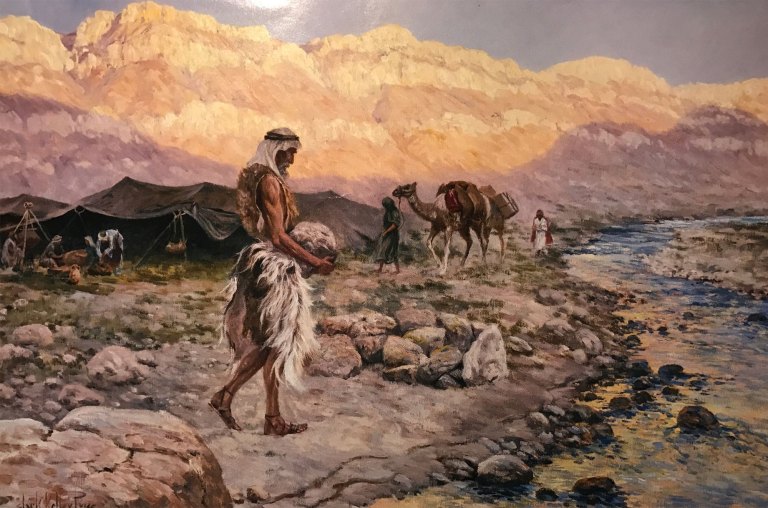
. . . Suppose you find some of the tribes making an altar of twelve stones . . . whereon they offer sacrifice, with the custom of washing, anointing
. . . Suppose you find all these gleanings of revelation and many more amongst a newly discovered people of . . . Hebrew physiognomy, would you feel justified in refusing to acknowledge in this interesting people, the outcasts of Israel, who, when the times of the Gentiles are ending, must be brought to light, identified, and instructed . . . preparatory to their re-possession of their own land? [p. 30]
Worthiness of Columbus
For the significance of Christopher Columbus’ virtues as a Book of Mormon parallel, see MP 286 (North American Review):
God stirred up the mind of Columbus, for the discovery of this unknown region and people. . “He mentions this early determination of his mind as a secret impulse from DEITY, ..inspiring him . . .” [citing “Letter to the Castillian Sovereigns, 1501.”]
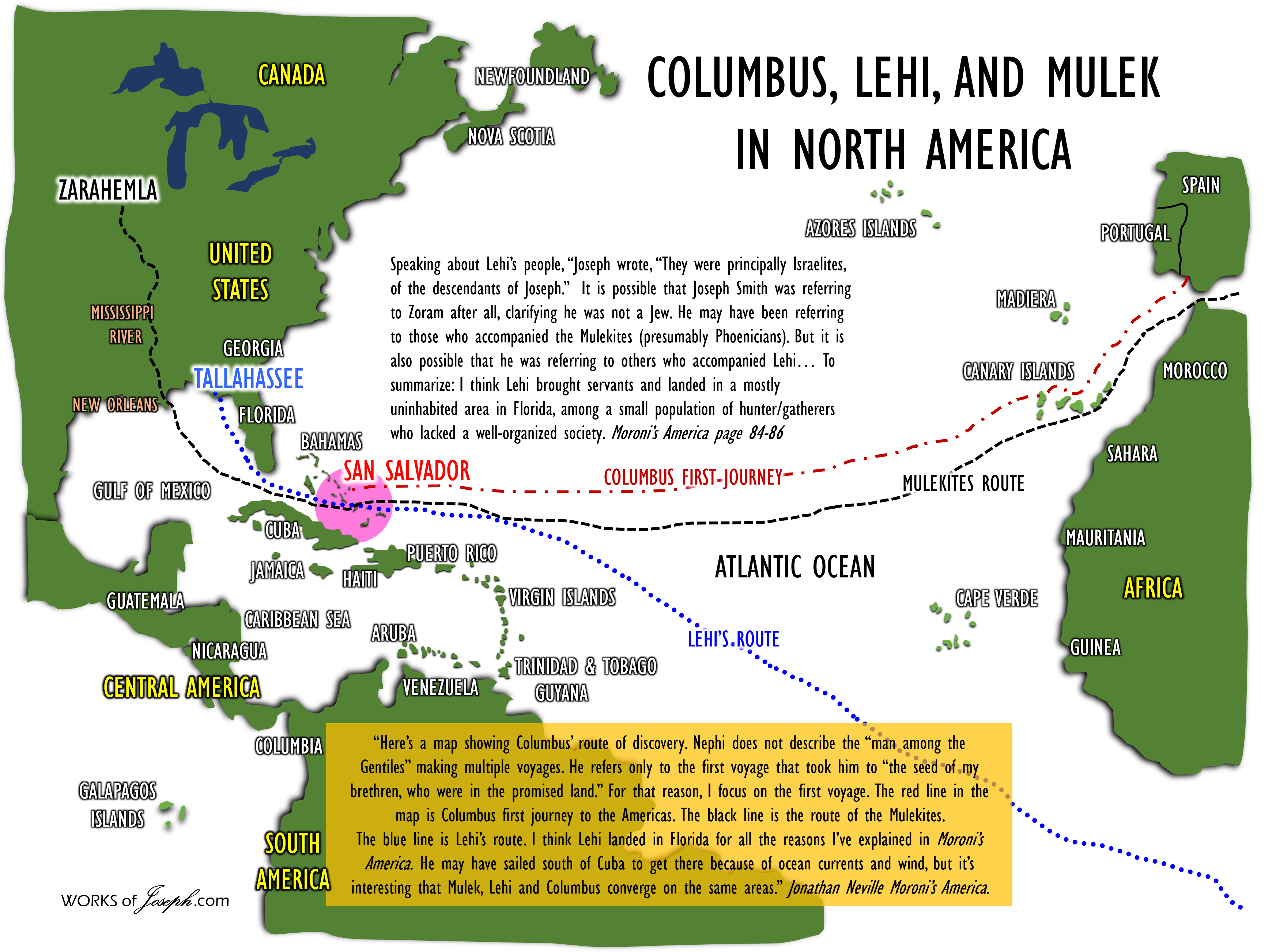 “. . . He never spoke in doubt or hesitation, but with as much certainty as if his eyes had beheld the promised land. . . . He looked upon himself as standing in the hand of Heaven, chosen from among men, for the accomplishment of its high purpose. [p. 31]
“. . . He never spoke in doubt or hesitation, but with as much certainty as if his eyes had beheld the promised land. . . . He looked upon himself as standing in the hand of Heaven, chosen from among men, for the accomplishment of its high purpose. [p. 31]
. . . His visionary spirit took fire . . . , pouring forth those magnificent texts of Scripture, and those mysterious predictions of the prophets, which in his enthusiastic moments he considered as types and annunciations of the sublime discovery which he proposed!” [pp. 31-32, citing “Irving’s Life of Columbus.” (MP 200)] 1574 Mormon Parallels: A Bibliographic Source © 2014 Rick Grunder
Breastplate and Urim
In resemblance to the ancient breast-plate, their archimagus wears a white conch
shell, with two holes bored in the middle of it, through which he puts the ends of
an otter-skin strap, and fastens a white button of buck’s horn to each, as if in
imitation of the precious stones of the Urim. Instead of the golden plate which
the Levite wore on his forehead . . . the Indian wears around his temples a
wreath of swan feathers . . . [p. 54]
. . . the Indian magi . . . have a transparent stone, of supposed great power . . . This stone, they assert, would suffer a great decay, were it even seen by their laity; but if by foreigners, it would be utterly despoiled of its divine communicative power. Does not this allude to the precious blazing stones of the Urim and Thummim? [p. 56] The Indian priests and prophets are initiated by anointing. The Chickasaws, some time ago, set apart some of their old men. They first obliged them to undergo a medicated vapour-bath . . . in a small green hut, constructed for the purpose . . . their priestly garments and ornaments are put on, bear’s oil being poured on their heads. If they could procure olive, or palm oil, they would prefer it . . . [pp. 83-84]
Sanctified Rod
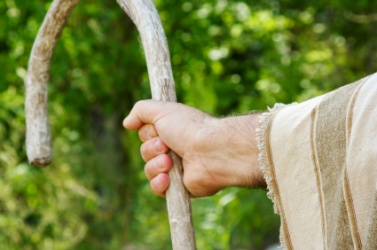 The Indians have an old tradition, that when they left their own native land, they brought with them a sanctified rod, by order of an oracle, which they fixed every evening in the ground, and were to remove from place to place on the continent towards the sun rising, till it budded in one night’s time. . . . Instead of the miraculous direction, to which they limit it, in their western banishment, it appears more likely that they refer to the ancient circumstance of the rod of Aaron . . . [p. 92]
The Indians have an old tradition, that when they left their own native land, they brought with them a sanctified rod, by order of an oracle, which they fixed every evening in the ground, and were to remove from place to place on the continent towards the sun rising, till it budded in one night’s time. . . . Instead of the miraculous direction, to which they limit it, in their western banishment, it appears more likely that they refer to the ancient circumstance of the rod of Aaron . . . [p. 92]
Brazen Copper Tablets
On the Tallapoose river, thirty miles above the Alabamah garrison, are two brazen tablets, and five of copper. They esteemed them so sacred as to keep them constantly in their holy of holies . . . Old Bracket, an Indian chief of a hundred years, . . . gave the following description of them. He said he was told by his grandfather that those plates were given to them by the chief we call God, that there had been many more of other shapes, some as long as he could stretch with his arms, and some had writing upon them, but these were buried with particular beloved men. [p. 94]
Quetzalcoatl
Moses seems to have been in the eye of the Mexicans, who they denominated Quetzalcoatl
. . . Though their ancient legislator is called by a name importing a serpent of green feathers, yet he was an ancient man and white-bearded, called by Montezuma a saint, who led and taught them many things. The brazen serpent in the wilderness and its healing power might have been implied by that figure, and the green plumage, which is their ‘amulet.’ This green plumage is a precious symbol of healing virtue, which is kept in their ark, and their ‘medicine bag.’ [p. 108] Mormon Parallels: A Bibliographic Source © 2014 Rick Grunder 1575
We believe it is very likely that the Lord Jesus Christ appeared to people in other parts of the world, such as South America or Japan or New Zealand. We just don’t have those records. I believe the Book of Mormon is the records of Ephraim from the Land of Joseph or the location of the United States today. Elder Perry said, “The United States is the promised land foretold in the Book of Mormon—a place where divine guidance directed inspired men to create the conditions necessary for the Restoration of the gospel of Jesus Christ.” Elder L. Tom Perry Ensign Dec. 2012
Breastplate; Sacred Garments
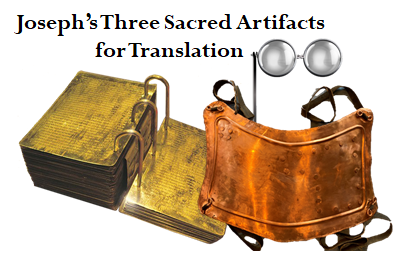
Mormon Parallels continued… “As the high-priest of old was inducted into office by various ceremonies and anointings, so is the Indian high priest by purification and by anointing. When the sacred garments are put on him, bear’s oil is poured on his head. The imitation of the ancient breast-plate is among the other priestly vestments. He appears in the rude temple, arrayed in white deer-skin garments.” [p. 127, citing “Dr. Beatty” (i.e. Charles Beatty, The Journal of a Two Months Tour . . . London: Printed for William Davenhill and George Pearch, 1768)]
A Good Book
It has frequently been stated, that these tribes have a tradition, that they were once, when in a far distant country, in possession of the good book which contains their old divine speech; which they hope to recover, and with which they hope to be happy at a future time. [p. 132]
There are those who contend for the utter extirpation of the Indians. The belief that they are descended from the Ten Tribes must have a tendency to soften the minds of mankind towards them. This belief is gaining ground, and even among some of those who once violently contended against the belief. It is a sound truth that the Indians are descended from the Ten Tribes, and time and investigation will more and more enforce its acknowledgment.” [p. 194] Mormon Parallels: A Bibliographic Source © 2014 Rick Grunder EVIDENCES
About Mormon Parallels
“Both the theory and the product of this work continue to be appreciated by some people, and misunderstood by others. Some go into the modern parallels expecting too much, or leave seeing too little. This is a call for sustained historical inquiry. We will never find a Jesus autograph, for example, yet unremitting painstaking work continues to add to the world’s understanding of ancient Christianity. That same principle applies here. Vast bodies
of data are required to distill a little of Mormonism. We must return to the field again and again, never presuming to find it all.
 This is a sourcebook, not a monograph. I have indulged in a few essays here and there, but my main purpose follows a lifetime commitment to assemble and share whatever potentially significant discoveries this occupation can provide. In response to my Preliminary Bibliography of parallels in 1987, author/bookseller Madeleine B. Stern suggested that I had seen things which others had not, but that was a duty, she hinted, not a boast. The trust remains sacred, and it must not be abused.
This is a sourcebook, not a monograph. I have indulged in a few essays here and there, but my main purpose follows a lifetime commitment to assemble and share whatever potentially significant discoveries this occupation can provide. In response to my Preliminary Bibliography of parallels in 1987, author/bookseller Madeleine B. Stern suggested that I had seen things which others had not, but that was a duty, she hinted, not a boast. The trust remains sacred, and it must not be abused.
When I resigned my post in 1981 as Chairman of the Bibliographic Department of Brigham Young Universityʹs Harold B. Lee Library, it was to fulfill the long stipulated dream of running my own rare book business. My boss Dean Larsen, a nurturing friend and Associate University Librarian, suggested that I take a number of the Library’s duplicate books on consignment to sell for them, since I didn’t have much of my own. It was in a little storage room at the back of the top floor that he handed me something I had never seen before – and wouldn’t have noticed anyway, since Americana was hardly my field.
ʺWhat’s this?ʺ
ʺIt’s from the 1830s, about American Antiquities . . . by a man named Josiah Priest.ʺ
ʺAnd?ʺ
ʺ–and it has something to do with Mormonism.ʺ
I probably hadn’t heard of “Mormon parallels” before, so no lights flashed. No music rose in the background. There was no voice to announce that something important had just happened, but maybe I needed a magnificent obsession, and apparently it had just begun. There’s enough about that in the general introduction that follows, further below. But first, some biblio name dropping:
While still in my twenties, I had to be the luckiest Mormon book geek in the universe, lunching constantly for years with A. Dean Larsen, and frequently with Chad Flake and Peter Crawley. I can never explain how well these masters of historical bibliography treated me. And among the sterling student employees who helped us in our work – and there were many – two were not only exceptionally able young bookmen and the best of all possible workers, but they continue in paths of information, and remain my friends and occasional advisers even now: Russ Clement (Art Collection, Deering Library, Northwestern
University) and Rick Turley (Assistant Church Historian, Church of Jesus Christ of Latter-day Saints).” By Rick Grunder PREFACE to the SECOND EDITION, with continued ACKNOWLEDGEMENTS page 9-10, 2014
I pray that you will read this information and study it to know truth or error. I continue to believe that reading good books will add to our knowing of truth of all things as Moroni promised us.

